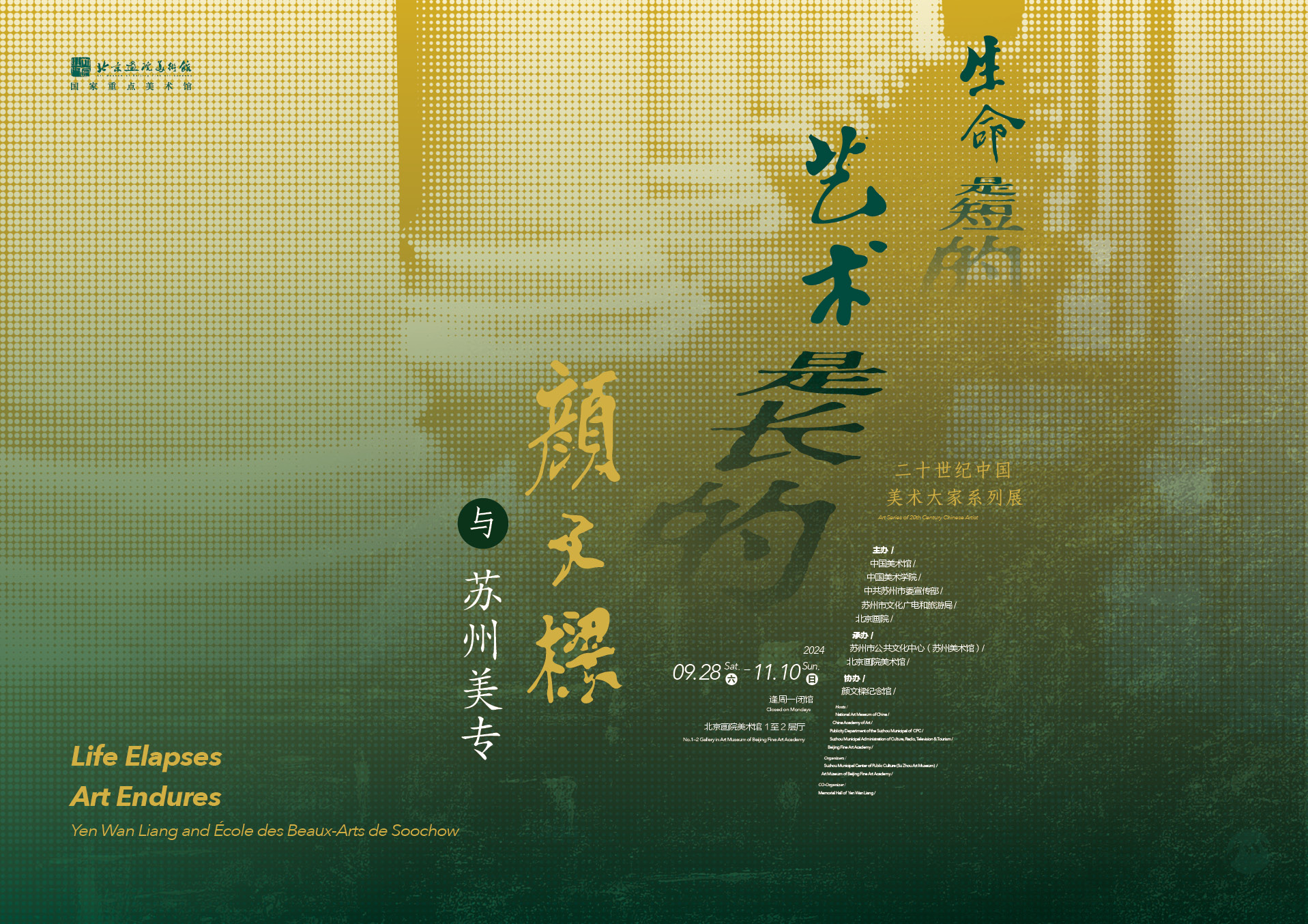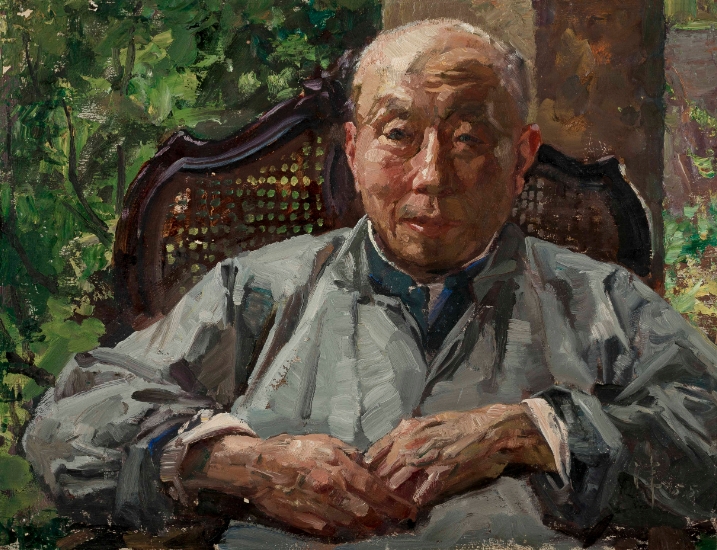Life Elapses, Art Endures: Yan Wen Liang and École des Beaux-Arts de Soochow

- show time:2024-09-28 to 2024-11-10
- Organizer:National Art Museum of China, China Academy of Art, Publicity Department of the CPC Suzhou Municipal Committee, Suzhou Municipal Bureau of Culture, Radio, Film and Television and Tourism, and Beijing Fine Art Academy
- venue:Beijing Fine Art Academy
The “Life Elapses, Art Endures: Yan Wen Liang and École des Beaux-Arts de Soochow” exhibition will be opened at the Art Museum of Beijing Fine Art Academy on September 28. The exhibition is jointly hosted by the National Art Museum of China, China Academy of Art, the Publicity Department of the CPC Suzhou Municipal Committee, the Suzhou Municipal Bureau of Culture, Radio, Film and Television and Tourism, and the Beijing Fine Art Academy. It is the second solo exhibition of oil painting masters after “Zhong Han Art Exhibition” in the “20th Century Chinese Art Masters Series” held in the Art Museum of Beijing Fine Art Academy.
As for Mr. Yan Wenliang, despite devotion of his life to transplanting traditional Western paintings, he had a persistent love for his motherland and always hoped new cultural flowers would bloom on this land.
- Zhong Han
Yan Wenliang (or Yen Wan Liang in French) was born in Suzhou in 1893 and his parents were both good at painting. At the age of 12, he started to copy the Painting Manual of the Mustard Seed Garden under his father’s instruction. At the age of 17, he was admitted to the Printing House of the Shanghai Commercial Press as a technical intern. He first studied copperplate engraving in the copperplate department and later transferred to the drawing department to study Western painting. In 1912 when he was at 20, Yan returned to Suzhou at his father’s order and began to study oil painting on his own.
Yan had multiple identities through his life. As well as being a painter and an educator, he was also the initiator of the Suzhou Art Painting Competition, the president of Suzhou Art Academy (or “École des Beaux-Arts de Soochow” in French), the founder of Suzhou Art Museum, and a father of modern Chinese art education. In the 1920s, Yan went to study at the L'Ecole Superieure Nationale des Beaux Arts in France, bringing back not only over 460 precious plaster statues for teaching at the Suzhou Art Academy, but also advanced educational philosophy from European art academies.
Wu Hongliang, president of the the Beijing Fine Art Academy, wrote in the preface to the exhibition: “What Yan Wenliang left to the Chinese art community is not only a wealth of works, but also a monument that can be reviewed and studied, and from which we can look forward to the future. Suzhou Art Academy is this monument... Yan elevated his art works to the peak of Chinese art in the 20th century by integrating Eastern and Western styles. Not only that, as a founder of Chinese art education, he was on par with masters such as Lin Fengmian, Xu Beihong, and Liu Haisu.”
In July 1922, Yan Wenliang, Hu Cuizhong, Zhu Shijie, Gu Zhonghua, and Cheng Shaochuan jointly founded the Suzhou Summer Art School. In September, the Suzhou Art School was established where a two-year crash course was offered. In the autumn of 1930, Suzhou Art School was renamed Suzhou Art Academy.
In September 1952, as part of a nationwide adjustment to departments of China’s institutions of higher education, the Suzhou Art Academy, the Shanghai Fine Arts School, and the Art Department of Shandong University formed the East China Arts Academy (now Nanjing University of the Arts), and the animation department of the Suzhou Art Academy was merged with the Beijing Film Academy. Two months later, Yan Wenliang was transferred to the post of vice-director of the East-China Campus of Central Academy of Fine Arts (now China Academy of Art), starting a new teaching career by traveling between Shanghai and Hangzhou.
In 1965, Yan Wenliang, who was aged over 70 at that time, stuck to his post as a teacher at the Zhejiang Academy of Fine Arts (now China Academy of Art). For this reason, when planning this exhibition, we thought of building an exhibition framework by drawing inspiration from his painting class, aiming to tell the story of his lifelong efforts in painting exploration and teaching.
In the 1930s, Yan Wenliang built an Ionic building next to the Canglang Pavilion in Suzhou as a new school building of the Suzhou Art Academy. These classical columns are now transferred to the exhibition hall on the first floor of the museum in order to start the exhibition journey with the Suzhou Art Academy, allowing the visitors to review its 30-year history. The exhibition will also specially put on display a great number of precious historical objects that can only be seen in the Memorial Hall of Yan Wenliang in Suzhou, such as the school flag, emblem, and magazine of the Suzhou Art Academy as well as customized painting folders.
The exhibition hall on the second floor is designed as Yan Wenliang’s teaching space which consists of three subjects, namely watercolor and pastel painting, night scene oil painting, and sketching. That means visitors will have a chance to walk into Yan’s classroom at the Suzhou Art Academy and the China Academy of Art to listen to his painting experience and appreciate his artistic works at close range. This exhibition brings together more than 60 essential collection items from the National Art Museum of China and the Suzhou Municipal Center of Public Culture, making it the largest exhibition of Yan Wenliang’s works in Beijing in recent years. The exhibits include Yan’s most representative watercolor and oil painting works as well as two pastel paintings with a history of about a hundred years.
Imitation, sketching and realistic depiction are the main features of Yan Wenliang’s artistic works. In 1920, he spent several days creating Kitchen, a realistic sketch pastel painting that depicts the life scene in a typical old-style kitchen. During his study in France, Kitchen was selected for the Paris Spring Salon and won an honorary award, becoming Yan Wenliang’s most important pastel painting work.
Pastel painting was introduced to China during the “May Fourth Movement” period. Special paper and pens are needed to create pastel paintings. Pastel is a dry crayon made of pigment powder which has rich, saturated and bright colors. It can be directly used on the painting without mixing colors in advance. Pastel paper often comes in different base colors such as gray, beige, brown, and dark green. Its rough texture allows easy coloring. The color of pastel paintings doe not change easily. The finished work will remain intact permanently if processed by the spray fixative and frame immediately after its completion. That is why today we can have the chance to appreciate these pastel painting masterpieces created more than a hundred years ago. Pastel paintings are thicker than watercolor paintings, more saturated than gouache paintings, and more bright than oil paintings. In his own words, “The beauty of pastel paintings is like the wings of a butterfly, while that of oil paintings is like the colorful body of a golden beetle.”
Father-in-law, by Yan Wenliang, 41.5×27cm, pastel painting on paper, 1919, collected in the Suzhou Municipal Center of Public Culture
The exhibition is titled “Life Elapses, Art Endures: Yen Wan Liang and École des Beaux-Arts de Soochow”, implying that the life of an artist is limited, but the power of education is unlimited. Despite that the Suzhou Art Academy existed for only thirty years, the western classical school building next to the Canglang Pavilion still stands firm there. It currently serves as the Memorial Hall of Yan Wenliang, a physical symbol of his establishment of modern art education in China.
You are now invited to attend Yan Wenliang’s art class at the Art Museum of Beijing Fine Art Academy from September 28 to November 10. Through this exhibition, you will have the chance to walk into the Suzhou Art Academy and Yan Wenliang’s painting classroom to learn about this artist master and his lifelong dedication to art education. In this Autumn, the most beautiful season in Beijing, we hope Yan Wenliang’s works will shine brightly in the Art Museum of Beijing Fine Art Academy.
[Artist profile]
Yan Wenliang (1893-1988)
Yan Wenliang, whose courtesy name was Dongchen, was born in Suzhou, Jiangsu Province. He was an artist, an educator, the founder of Suzhou Art Academy and a father of modern and contemporary art education. He initiated the Suzhou Art Painting Competition in 1919, founded the Suzhou Art Academy in 1922, and went to study at the L'Ecole Superieure Nationale des Beaux Arts in France between 1928 to 1930. He was devoted to the creation of oil paintings, pastel paintings, and watercolor paintings through his life. In 1952, the Suzhou Art Academy was merged into the East China Arts Academy (now Nanjing University of the Arts) as part of a national reorganization of art schools by the Chinese Communist Party. The posts he held include vice-director of the East China campus of the Central Academy of Fine Arts (CAFA) and vice-chairman of the Shanghai Branch of the Chinese Artists Association.

.jpg)
.jpg)
.jpg)
.jpg)
.jpg)
.jpg)
.jpg)
.jpg)
.jpg)
.jpg)
.jpg)
.jpg)
.jpg)
.jpg)
.jpg)
.jpg)
.jpg)
.jpg)
.jpg)
.jpg)
.jpg)
.jpg)